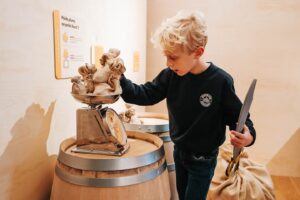
There are only eight bones, but they complicate the already complex story of human evolution. In 2009, at the Woranso-Mille site (Afar, Ethiopia), fragments of the foot of an individual who walked upright almost 3.4 million years ago were discovered. This was all that was believed Australopithecus afarensisgroup to which he belonged Luciaconsidered the common ancestor of the upright primates that came later, including man. Its discoverers did not know what species that foot belonged to, but they were sure that it was not the species of Grandma Lucia. The skepticism of paleoanthropologists was such that the foot has remained orphaned to this day. A work published this Wednesday in Nature and guided by the same person who discovered those eight bones, he found an owner: it was another type of australopithecus (Australopithecus deiremeda). and lived with Luciaand was bipedal like her, but still showed a love for trees.
“This work is supported by new findings that clearly associate the foot with a A. deiremeda“, says in an interview Yohannes Haile-Selassie, director of the Institute of Human Origins and professor at Arizona State University (United States). In 2015, his group found a large number of teeth, a jaw and incomplete jaws of a new species of australopithecine to which they gave the name deiremeda. In the Afar language of the region, it means something like a close relative. The importance of that discovery was that it was included in the list of possible ancestors of all human beings. Haile-Selassie was convinced that the foot must have belonged to one of those close relatives, but he couldn’t draw the dotted line to this new work.
Thanks to the new supply of teeth, particularly the nearly complete jawbone of a young individual who still had baby teeth, the 2009 foot is now seen in a different light. Among paleontologists and anthropologists there is a sort of unwritten law: without a new skull it is difficult to accept a new species. But by combining the foot with what was discovered in 2015 and the new remains, its discoverers can say much more about the A. deiremeda. The eight bones of the limb, in particular the more elongated phalanges and the portion of the big toe found, which resembles that of chimpanzees, indicate that it walked on two legs, but was still arboreal. And this is reinforced by the study of his teeth.
“Teeth provide us with a lot of information,” summarizes University of Michigan researcher and study co-author Naomi Levin. The dating of the remains of A. deiremeda found in three different places, but all a few kilometers from Hadar, where the skeleton of Luciaindicates that they coincided in time and space. “However, tooth chemistry shows that these two closely related hominids had different behaviors, although their development was similar,” Levin continues in an email.
The analysis of the carbon isotopes present in the enamel reveals that the afarensis Not only did they eat a greater variety of foods, but many of them already came from the earth, grass, herbs, etc. deiremeda They suggest that they still fed on leaves and fruits, that is, on the tree.
Haile-Selassie argues that there were two species that coexisted, although they had different locomotor adaptations. “Now we can say that A. afarensis AND A. deiremeda They were close, but they did different things.” With differentiated mobility and nutrition, both lineages were able to coexist without having to compete, that is, without having to kill each other. Otherwise “one of the two would have become extinct”, concludes Haile-Selassie.

Geologist Lluís Gibert, from the University of Barcelona, has been accompanying Haile-Selassie for years in his excavations in northern Ethiopia. Co-author of the new work, he recalls that fossils are found within sediments and those sediments indicate what the environment was like. “The evolution of the physical environment is what conditions human evolution,” he emphasizes. “Africa was splitting in two,” Gibert recalls. “This disruption process has affected the evolution of the landscape, moving from a more jungle-type forest environment, like the one where gorillas currently live, to another type of savannah.” It is in that transition, in that place, that the roots of human evolution would be found.
To know the role that the owner of that foot had in this evolution, the head is missing. Fred Spoor, of the Natural History Museum in London, summarizes it in a comment on the study also published on Nature. “Attributing limb or trunk bones to a species is a matter of probability, unless they are part of an individual skeleton that preserves diagnostic features of the species, which are usually limited to the skull,” he writes.
Even more skeptical is Leslea Hlusko, paleobiologist at the National Center for Research on Human Evolution (Cenieh) and a great expert on the dental variation of early hominids. Your first objection has to do with bipedalism. “The dilemma lies in the difficulty of definitively interpreting the angle of the big toe from the base of the foot, using only the metatarsal. You need the bone with which it articulates: the cuneiform,” he says in an email. And they still haven’t found these bones in Woranso-Mille.

“It would be extraordinary to have two almost identical-looking monkeys living next to each other without interbreeding,” Hlusko acknowledges, something that has not been seen “in current primates, which is why I am extremely skeptical of all these interpretations of extreme biological diversity,” he adds. Although scientist Cenieh highlights the new findings, she reminds us that “fossil evidence is the only information we have about what these animals looked like and to determine when and where they lived.” And he concludes about the new work: “It offers us no new perspective on the biology of our ancestors 3.5 million years ago; that’s why we still need more fossils.” We’ll have to wait until they find a’s skull A. deiremeda.





